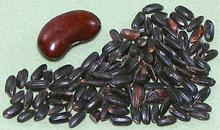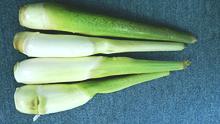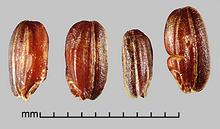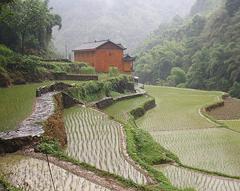China Black
 [Forbidden Rice]
[Forbidden Rice]
Said to once have been reserved exclusively for the emperor, this almost black medium grain rice turns a very dark purple when cooked. It is sold only "brown" to preserve the color and texture. Lotus Foods claims to have a copyright on the name "Forbidden Rice". The photo specimens, from China by way of Lotus Foods, were typically 0.215 inches long by 0.100 inch wide (5.5 x 2.5mm). A cup of this rice needs about 2-1/4 cups of water and about 60 minutes of cooking to make about 3 cups. The grains remain quite firm and very separate and the flavor is deep and pleasant. This is about the only rice anyone imports from China, but that is no longer necessary since a very fine derivative of this rice, Nero Venere, can now be purchased more economically right off the shelf in Italian markets.
Wild Rice - Manchurian
 [Manchurian Ricegrass; Gu (China); Makomotake (Japan); Zizania latifolia]
[Manchurian Ricegrass; Gu (China); Makomotake (Japan); Zizania latifolia]
This rice is related to the North American Wild rice. It was once an important grain in Manchuria, but today is used only for its stems. Now rare in the wild, it is a cultivated crop. Success of cultivation depends on the stems being infected by a fungus, Ustilago esculenta. This fungus causes the stems to swell up to as much as 1.6 inches diameter for a length of about 10 inches.
Used as a vegetable, it is appreciated for its tender texture and flavor
(similar to bamboo shoots), and is eaten both raw and cooked. It remains
crisp when stir fried. This grass is considered an invasive in New Zealand,
and it has been introduced to Hawaii. Import to mainland United States
is illegal, to protect North American Wild Rice from the fungus.
Wild Rice - Asian
 [Oryza rufipogon and hybrids]
[Oryza rufipogon and hybrids]
Various varieties of this wild rice are a difficult to eradicate crop pest
of no commercial value. The seed heads of these varieties tend to shatter
(ripen unevenly and spill their seeds as they ripen). If seeds make into the
harvest, consumers may think they are spoiled, or not really rice, and they
take nutrients intended for the crop. They are listed as "noxious weeds"
in several US States, but these wild varieties are used by plant geneticists
developing new commercial rice varieties.
Photo by Julia Scher, Federal Noxious Weed Disseminules of the
U.S. (Federal Government) = public domain.
 [Oryza sativa var japonica (Northeast) Oryza sativa
var indica (Southeast)]
[Oryza sativa var japonica (Northeast) Oryza sativa
var indica (Southeast)]